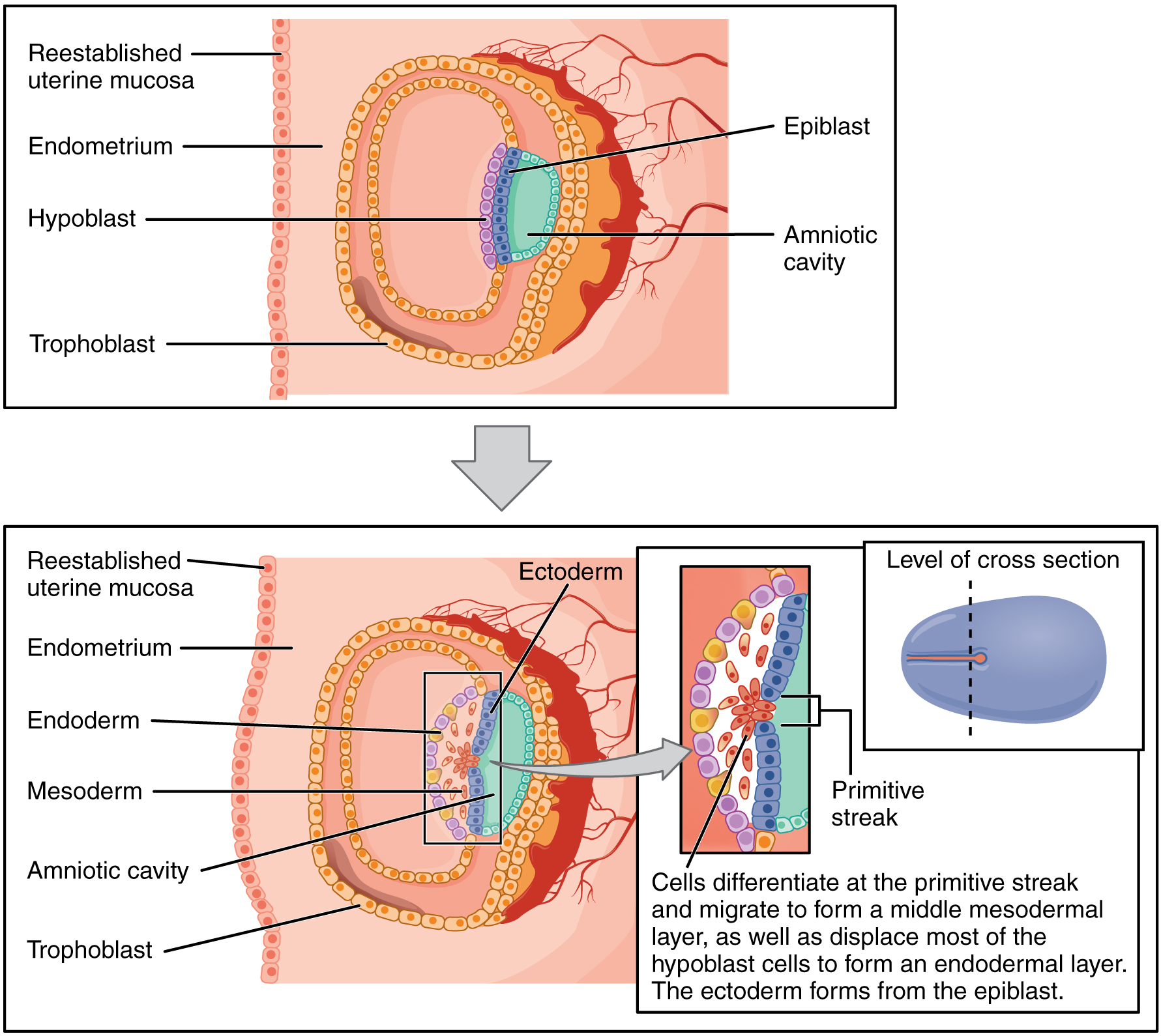Playlist
Show Playlist
Hide Playlist
Mesoderm Derivatives: Paraxial and Intermediate Mesoderm
-
Reference List Embryology.pdf
-
Slides Mesoderm Derivatives Paraxial and Intermediate Mesoderm.pdf
-
Download Lecture Overview
00:01 Now, we´re gonna discuss the mesoderm and the structures that form from it. 00:05 We´re gonna start with the paraxial mesoderm and then move to the intermediate mesoderm. 00:10 So please remember that we discussed how the ectoderm folds the neural tube which is gonna fold into the mesoderm and take up residence just above the notochord. 00:20 On either side it´s flanked by paraxial mesoderm. 00:23 Now, this paraxial mesoderm as development proceeds is gonna form structures that are called somites. 00:29 Now, the somites are actually distinctive bulges that are present and visible on the dorsal surfaces of the embryo. 00:37 So if we look at the image on the left we can see them starting to form, but as the neural tube fully moves into the mesoderm and the embryo on the right we can see distinctive and clear somites on either side. 00:50 Now, the somites are closely associated with each spinal level and therefore we´re gonna see 4 occipital, 8 cervical, 12 thoracic, and then 5 lumbar, 5 sacral and a variable number of coccygeal somites. 01:05 Now, the somites are coming from the paraxial mesoderm and are going to split into three separate regions that would come up with three distinctive sets of structures. 01:17 The first one is called the dermatome and the dermatome becomes part of the skin. 01:22 The ectoderm creates the epidermis, the outermost layer of skin, but the dermatome becomes the inner layer of the skin, the dermis. 01:31 Deep to that is the myotome and as its name suggests the myotome is gonna create muscles, specifically the muscles of the trunk, the back and the limbs. 01:43 Now, deepest of all is the sclerotome and sclerotome is gonna form bony structures that largely protect the developing neural tube and spinal cord. 01:53 So it´s gonna form the vertebra, the intervertebral discs, the meninges, the structures that line the spinal canal and the ribs. 02:01 So here we can see that the mesenchyme that´s present in the sclerotome is starting to differentiate into a little model that´s going to form bone. 02:12 Now, in this image it doesn´t initially look much like a vertebra but there are various regions, the ventral, dorsal, lateral and central regions of the sclerotome that are gonna migrate to form an actual model of the vertebra. 02:25 The body and pedicles are gonna come from the ventral and central portions of the sclerotome. 02:33 More laterally, the lateral region is gonna form the transverse processes and extend outward to form the ribs. 02:40 The dorsal region´s gonna go back and surround the neural tube completely and form the spinous processes and lamina of each vertebra. 02:50 And then, the inner most region that´s in contact with the spinal cord is gonna form the meninges, the protective layer, the dura mater, arachnoid mater and so forth. 03:01 And so in the process you can see how it starts to look a little bit more like a vertebra. 03:05 Now, let´s move one layer out from the paraxial mesoderm to the intermediate mesoderm. 03:12 Intermediate mesoderm is easy to remember because it´s going to form the gonads, which are the ovaries or testes, and the kidneys. 03:21 During development the body wall wraps around the trilaminar embryo and in the process make sure that the kidneys and the gonads wind up what´s called retroperitoneal or they´re behind the peritoneal cavity. 03:36 So here we can see the nephrogenic cord and urogenital ridge form into the intermediate mesoderm. 03:43 Now, the nephrogenic cord is gonna form the early kidney and the urogenital ridge is gonna form either the testis or the ovary. 03:51 Now, posterior inside the retroperitoneal we´re gonna have the developing kidneys and just superficial to that, the urogenital ridge which will form the testes and the ovaries and each one of those topics will have their own discussion and talk coming up in the near future. 04:06 Thank you very much and we´ll move on to discuss the fate of the lateral plate mesoderm hich actually makes the body wall that surrounds all of these structures. 04:15 WT1 mutations are examples of what can go wrong during the development of the intermediate mesoderm. 04:21 The expression of the WT1 gene is important in the normal development of the intermediate mesoderm. 04:28 Therefore, mutations in this gene can result in abnormalities in the development of structures that arise from the intermediate mesoderm. WT1 mutations are associated with renal agenesis and gonadal dysgenesis. 04:44 Moreover, the myocardium in patients with WT1 mutations is found to be thinner than those with normal WT1.
About the Lecture
The lecture Mesoderm Derivatives: Paraxial and Intermediate Mesoderm by Peter Ward, PhD is from the course Early Development and the Organogenic Period.
Included Quiz Questions
The ribs arise from what region of the somite?
- Lateral sclerotome
- Dorsal sclerotome
- Ventral sclerotome
- Central sclerotome
- Meningotome
The nephrogenic cord derives from which embryonic layer?
- Intermediate mesoderm
- Lateral plate mesoderm
- Cardiogenic mesoderm
- Paraxial mesoderm
- Extraembryonic mesoderm
Customer reviews
5,0 of 5 stars
| 5 Stars |
|
1 |
| 4 Stars |
|
0 |
| 3 Stars |
|
0 |
| 2 Stars |
|
0 |
| 1 Star |
|
0 |
Hello Professor Ward. M1 student from CA here. I just wanted to say that I think these lectures are super awesome, and thank you for taking the time for ensuring good quality while also making great responses to student questions.




